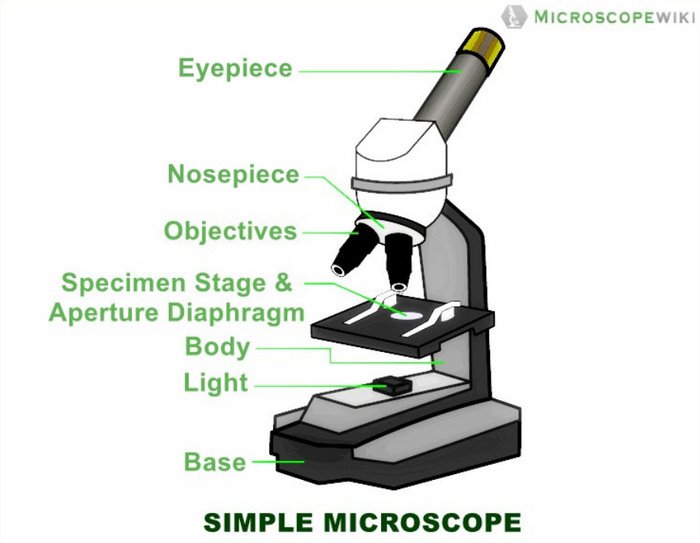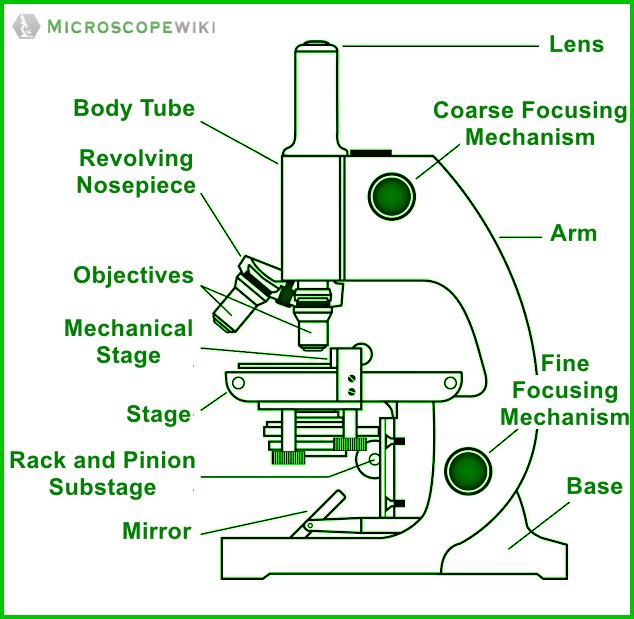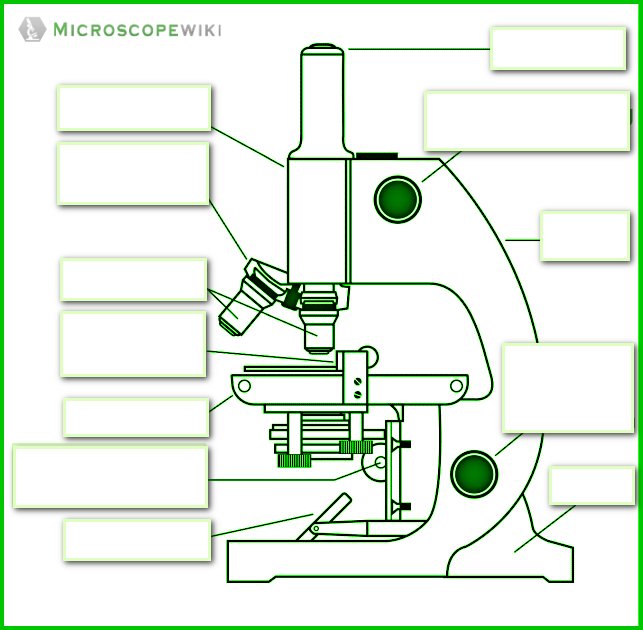Dating back to the 14th century, simple microscope is the most basic of the various microscopes available. It is a type of optical microscope that uses visible light and lens to magnify objects.
Despite the fact that they are rudimentary imaging devices, simple microscope finds use in microbiology to study biological specimens and microscopic organisms such as fungi, hydra and algae.
They are also used by pedologists to study soil samples and dermatologists to study skin samples.
Definition and Working principle
Simple microscope is a magnification apparatus that uses a combination of double convex lens to form an enlarged, erect image of a specimen.
The working principle of a simple microscope is that when a lens is held close to the eye, a virtual, magnified and erect image of a specimen is formed at the least possible distance from which a human eye can discern objects clearly.
Magnification formula
The magnification power of a simple microscope is expressed as: M = 1 + D/F
Where
M = Magnification power
D = the lease possible distance of distinct vision of eye, typically 25cm
F = Focal length of the convex lens
It is to be noted that
- The magnification power of a simple microscope is about 10, meaning that the specimen being studied is enlarged by 10 times to view the tiny organisms not visible to the naked eye
- The focal length of the convex lens used needs to be small because of the fact that lower the focal length, higher the magnification power of the microscope
Parts of a Simple Microscope
A simple microscope consists of
- Optical parts
- Mechanical parts

Labeled Diagram of simple microscope parts
Optical parts
The optical parts of a simple microscope include
- Lens
- Mirror
- Eyepiece
Lens
A simple microscope uses biconvex lens to magnify the image of a specimen under focus.
A typical microscope uses only one lens but latest simple microscopes also use an array of objective lenses that offer various magnifications levels and these lenses can also be moved farther or nearer to the specimen being studied to achieve higher or lower magnification depending on the need
Mirror
Simple microscopes use a mirror to gather ambient light from surroundings and this mirror acts as a light source to illuminate the specimen being observed.
Modern day simple microscopes also have an adjustable light source that can be used to focus light on the specimen
Eyepiece
Older generation simple microscopes used the lens as an eyepiece to view to the sample. But modern microscopes of today incorporate a combination of objective lenses that have different magnifying powers to achieve varying degrees of image magnification.
Mechanical Parts
The mechanical parts include
- Arm
- Stage
- Nosepiece
- Base
- Coarse focusing mechanism
- Fine focusing mechanism
Arm
The arm of a simple microscope is made of metal and it connects the base of the microscope with the lens tube that houses the eyepiece
Stage
This is a rectangular metal plate with a hole in the middle and is attached to the body of the microscope.
The hole in the middle is called the aperture and it allows the light to fall on the specimen. The specimen slide is placed on the stage and is held secure by a pair of clips.
Nosepiece
It is a revolving turret that houses two or more objective lenses that are used to achieve varying degrees of magnification depending on the need.
This nosepiece is a commoncomponent that is seen on all modern day simple and compound microscopes.
Base
The base is on which the microscope sits and it lends the stability to the microscope. The base also holds the mirror or light that is used to focus light through the aperture onto the specimen.
Coarse focusing mechanism
This is one of the two adjustment knobs on the microscope. The coarse adjustment knob is used to adjust the focal length to view the magnified specimen.
Fine focusing mechanism
This component is typically absent in a simple microscope but latest simple microscope feature this as well.
The fine focusing mechanism helps in making finer adjustments to clearly view the magnified image of the specimen put up for analysis.
For in-detail information on: Parts of Simple microscope
Simple Microscope Diagram (Parts) with Labels

Simple Microscope – Student Free Worksheet

Frequently Asked Questions
Q 1. How many lenses does a simple microscope have?
Simple microscope has one objective lens for magnifying the specimen
Q 2. When was the simple microscope invented?
The simple microscope was invented by Anton van Leeuwenhoek in 1675
Q 3. What is the difference between compound and simple microscope?
The basic difference between a simple microscope and compound microscope is the number of lenses used to magnify a specimen. While a simple microscope uses single lens to magnify an object, a compound microscope uses multiple lens to achieve higher order of magnification.
Q 4. How many parts are there in simple microscope?
Simple microscope has mainly two types of parts – Optical and Mechanical.
The optical parts include:
– Lens
– Mirror
– Eyepiece
The mechanical parts include:
– Arm
– Stage
– Nosepiece
– Base
– Coarse focusing mechanism
– Fine focusing mechanism
Q 5. What are the three types of microscopes?
The three types of microscopes are
Optical microscope – These use transparent lenses and visible light to see objects to the order of one micrometer ( one millionth of one meter
Charged Particle (ion and electron) microscope – These microscopes employ electrostatic or electromagnetic lens along with a beam of charged particles to focus on specimens. These microscopes can see objects as tiny as one nanometer ( one tenth billionth of one meter)
Scanning probe microscope – Thesemicroscopes don’t use lenses but use a sharp probe to probe the surface qof the specimen to view subatomic structures to the order of a nanometer.
Q 6. How are microscope classified?
Microscopes are generally classified based on the types of lenses used. A simple microscope employs a single lens while a compound microscope employs more than one lens to achieve higher order of magnification.
References:
- https://www.onlineschoolbase.com/p/optical-instruments-simple-microscope.html
- https://www.microscopeclub.com/simple-microscope/
- https://microbenotes.com/simple-microscope-principle-instrumentation-and-applications/
- https://byjus.com/physics/simple-microscope/
- http://www.funscience.in/study-zone/Physics/OpticalInstruments/SimpleMicroscope.php
- https://microbiologynotes.com/differences-between-simple-and-compound-microscope/